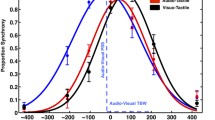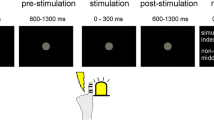Abstract
Following prolonged exposure to asynchronous multisensory signals, the brain adapts to reduce the perceived asynchrony. Here, in three separate experiments, participants performed a synchrony judgment task on audiovisual, audiotactile or visuotactile stimuli and we used inter-trial analyses to examine whether temporal recalibration occurs rapidly on the basis of a single asynchronous trial. Even though all combinations used the same subjects, task and design, temporal recalibration occurred for audiovisual stimuli (i.e., the point of subjective simultaneity depended on the preceding trial’s modality order), but none occurred when the same auditory or visual event was combined with a tactile event. Contrary to findings from prolonged adaptation studies showing recalibration for all three combinations, we show that rapid, inter-trial recalibration is unique to audiovisual stimuli. We conclude that recalibration occurs at two different timescales for audiovisual stimuli (fast and slow), but only on a slow timescale for audiotactile and visuotactile stimuli.


Similar content being viewed by others
Notes
A control experiment was conducted prior to the experiments to examine whether participants were able to hear the tactile stimulus. Participants saw the word ‘interval 1’ and ‘interval 2’ for 1 s on the screen (30 trials). On half of the trials, the tactile stimulus (50 ms duration) was presented during interval 1 and on the remaining trials during interval 2, and participants were required to indicate the interval. Overall performance was 47.3 % correct and not significantly different from chance level, t(17) = 1.4, p = .178, indicating that participants were not able to hear the tactile stimulus.
References
Alais D, Burr D (2004) The ventriloquism effect results from near-optimal bimodal integration. Curr Biol 14:257–262
Alais D, Carlile S (2005) Synchronising to real events: subjective audiovisual alignment scales with perceived auditory depth and speed of sound. Proc of the National Academy of Science 102:2244–2247
Cohen J (1988) Statistical power analysis for the behavioral sciences, 2nd edn. Erlbaum, Hillsdale, NJ
Di Luca M, Machulla T, Ernst MO (2009) Recalibration of multisensory simultaneity: cross-modal transfer coincides with a change in perceptual latency. J Vis 9:7
Fujisaki W, Shimojo S, Kashino M, Nishida S (2004) Recalibration of audiovisual simultaneity. Nat Neurosci 7:773–778
Hanson JVM, Heron J, Whitaker D (2008) Recalibration of perceived time across sensory modalities. Exp Brain Res 185:347–352
Harrar V, Harris LR (2008) The effect of exposure to asynchronous audio, visual, and tactile stimulus combinations on the perception of simultaneity. Exp Brain Res 186:517–524
Keetels M, Vroomen J (2007) No effect of auditory–visual spatial disparity on temporal recalibration. Exp Brain Res 182:559–565
Keetels M, Vroomen J (2008) Temporal recalibration to tactile–visual asynchronous stimuli. Neurosci Lett 430:130–134
Kösem A, Gramfort A, Van Wassenhove V (2014) Encoding of event timing in the phase of neural oscillations. NeuroImage 92:274–284
Luo H, Liu Z, Poeppel D (2010) Auditory cortex tracks both auditory and visual stimulus dynamics using low-frequency neuronal phase modulation. PLoS Biol 8:e1000445
Machulla T, Di Luca M, Froehlich E, Ernst MO (2012) Multisensory simultaneity recalibration: storage of the aftereffect in the absence of counterevidence. Exp Brain Res 217:89–97
McGurk H, MacDonald J (1976) Hearing lips and seeing voices. Nature 264:746–748
Morein-Zamir S, Soto-Faraco S, Kingstone A (2003) Auditory capture of vision: examining temporal ventriloquism. Cogn Brain Res 17:154–163
Munhall KG, Gribble P, Sacco L, Ward M (1996) Temporal constraints on the McGurk effect. Percept Psychophys 58:351–362
Navarra J, Soto-Faraco S, Spence C (2007) Adaptation to audiotactile asynchrony. Neurosci Lett 413:72–76
Shams L, Kamitani Y, Shimojo S (2000) What you see is what you hear. Nature 408:788
Slutsky DA, Recanzone GH (2001) Temporal and spatial dependency of the ventriloquism effect. NeuroReport 12:7–10
Sumby WH, Pollack I (1954) Visual contribution to speech intelligibility in noise. J Acoust Soc Am 26:212–215
Takahashi K, Saiki J, Watanabe K (2008) Realignment of temporal simultaneity between vision and touch. NeuroReport 19:319–322
Van der Burg E, Olivers CNL, Bronkhorst AW, Theeuwes J (2008) Pip and pop: non-spatial auditory signals improve spatial visual search. J Exp Psychol Hum Percept Perform 34:1053–1065
Van der Burg E, Cass J, Olivers CNL, Theeuwes J, Alais D (2010) Efficient visual search from synchronized auditory signals requires transient audiovisual events. PLoS ONE 5:e10664
Van der Burg E, Talsma D, Olivers CNL, Hickey C, Theeuwes J (2011) Early multisensory interactions affect the competition among multiple visual objects. NeuroImage 55:1208–1218
Van der Burg E, Alais D, Cass J (2013) Rapid recalibration to asynchronous audiovisual stimuli. J Neurosci 33:14633–14637
Van der Burg E, Cass J, Alais D (2014) Window of audio–visual simultaneity is unaffected by spatio-temporal visual clutter. Scientific Reports 4:5098
van Eijk RLJ, Kohlraush A, Juola JE, van der Par S (2008) Audiovisual synchrony and temporal order judgments: effects of experimental method and stimulus type. Percept Psychophys 70:955–968
van Eijk RLJ, Kohlraush A, Juola JF, van der Par S (2010) Temporal order judgment criteria are affected by synchrony judgment sensitivity. Atten Percept Psychophys 72:2227–2235
Van Wassenhove V, Grant KW, Poeppel D (2007) Temporal window of integration in auditory–visual speech perception. Neuropsychologia 45:598–607
Vroomen J, Keetels M, De Gelder B, Bertelson P (2004) Recalibration of temporal order perception by exposure to audio–visual asynchrony. Cogn Brain Res 22:32–35
Yarrow K, Roseboom W, Arnold D (2011) Spatial grouping resolves ambiguity to drive temporal recalibration. J Exp Psychol Hum Percept Perform 37:1657–1661
Author information
Authors and Affiliations
Corresponding author
Rights and permissions
About this article
Cite this article
Van der Burg, E., Orchard-Mills, E. & Alais, D. Rapid temporal recalibration is unique to audiovisual stimuli. Exp Brain Res 233, 53–59 (2015). https://doi.org/10.1007/s00221-014-4085-8
Received:
Accepted:
Published:
Issue Date:
DOI: https://doi.org/10.1007/s00221-014-4085-8




